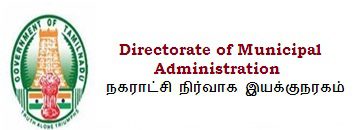The Government accords topmost priority to the creation of quality and efficient infrastructure. Creating and maintaining urban infrastructure is one of the greatest challenges to the ULBs. The Government accords topmost priority to the creation of quality and efficient infrastructure. Infrastructure works in Urban Local Bodies are taken up by accessing financial assistance from Central/State Government and external funding agencies like World Bank assisted Tamil Nadu Sustainable Urban Development Project, German Development Bank (KfW) and Japan International Cooperation Agency (JICA) and Asian Development Bank[ADB].
Wet Waste Processing Methods:
(a) Bio-Methanation Plants
47 bio-Methanation Plants with total capacity of 197 TPD has been established in 11 Corporations & 27 Municipalities at a project cost of Rs.37.42 crore under various schemes, to process the food waste, vegetable market waste, slaughter house waste etc. The capacity of plants ranges from 1 TPD to 10 TPD. The biogas is used in Gasifier Crematorium and the electricity generated from some of the plants are being used for illuminating the lights in the compost yards, MCCs and STPs.
(b) Decentralized Micro Compost Centre:
Decentralized approach is being implemented in all the Corporations and Municipalities after demarcating the ULB into service areas comprising of 4 to 5 wards. A Micro Composting Centre is established in each service area for processing the wet waste and converting into manure. This encourages the collection and disposal mechanism of wet waste in a decentralized manner which helps to minimise the secondary transportation cost and also to have bin free streets.
At present 804 Nos of Micro Compost Centres for handling the biodegradable waste of 3130 TPD are sanctioned of which 691 Nos of MCCs with the capacity of 2649 TPD are put to use in all Corporations and Municipalities. The manure generated from MCCs are distributed to farmers / households at free of cost.
(C) Windrows composting
258 TPD of wet waste in 36 ULBs (5 Corporations and 31 Municipalities) is being processed through Windrows Composting.
(d) Onsite Composting
Onsite Composting Centers (OCCs) are constructed in parks and gardens to process the horticultural waste. So far 876 OCCs are functioning in 14 Corporations & 121 Municipalities handling 416 TPD.
Incineration Plant
Incineration plants are proposed in feasible ULBs to process the combustible dry waste such as Plastics, Clothes and other combustible materials. Incineration plants with capacity like 10 TPD, 25 TPD and 50 TPD have been sanctioned in Erode, Salem, Vellore, Thanjavur, ThoothukudiDindugul& Tirunelveli Corporations and Karur, Tambaram, Idappadi and Mettupalayam Municipalities on cluster basis at an estimated cost of Rs.28.73 Crore for the years 2019-20& 2020-21.
Bio Mining and Bio capping of legacy waste
Reclamation of dump yard suffused with legacy waste is reclaimed through bio mining.Bio mining of old and abandoned dump sites have been taken up in 11 Corporations and 87 Municipalities to remove the 84.17 Lakh Cu.m of legacy waste through bio remediation process at a total estimate cost of Rs.530.37 Crores under Swachh Bharat Mission and Smart City Mission.
Bio Mining has been completed inKumbakonam, Pammal, Sembakkam, Poonammalle,Chidambaram, Pallavaram, Anakaputhur, Arani, Idappadi, Karur, Kangeyam, Bhavani, Mettupalayam,Sathyamangalam,Vellakoil&Bodinayakanur Municipalities by clearing 8,64,393Cu.m of legacy waste so far and 85.29 acres of land has been reclaimed. Bio mining in 82 ULBs are in various stages. Centre for Environmental studies, Guindy Campus, Anna University Chennai is engaged as Third Party inspection agency in 96 ULBs for guidance in technical aspects of Bio-mining works. Scientific Bio capping of legacy waste completed in Madurai, Coimbatore Salem and Tirunelveli Corporations.
Capital Grant Fund and Operational & Maintenance Gap Filling Fund
Capital Grant Fund (CGF):
Based on the 5th State Finance Commission (SFC) recommendation, Capital Grant fund is established replacing the Infrastructure Gap Filling Fund (IGFF) into which 15 % of the aggregate devolution intended for ULBs tier wise is paid. This fund has three parts corresponding to each tier of ULB and is being utilized to support capital works linked to basic functions and services in the ULBs.
During the year 2020-21 a total sum of Rs.261.31 Crore have been allocated under CGF for taking up various Infrastructure works. A sum of Rs.141.76 Crore has been allocated to 6 Corporations and Rs.119.55 Crore has been sanctioned to 18 Municipalities.
Operational and Maintenance (O & M) Gap filling Fund:
The allocation for Operational and Maintenance Gap filling is distributed to the Urban Local Bodies where fund is required for the Operational and Maintenance of the needy infrastructural facilities such as water supply, UGD and payment of dues to water charges and EB dues etc., Now the percentage of O&MGFF for each tier of ULBs is increased from 3% to 5%.
Under O & M Gap Filling Fund, during 2020-21 a total sum of Rs.119.12 crore has been allocated, out of which Rs.60.70 Crore sanctioned to 14 Corporations and Rs.58.42 Crore to 86 Municipalities.
Integrated Urban Development Mission (IUDM).
IUDM has been re-launched in the year 2018-19 with an annual grant of Rs.750 crore from state funds for Corporations (except Chennai), Municipalities to improve the basic Infrastructure facilities such as Water Supply, Sewerage and Sanitation, Roads & Street lights, Strom Water Drain, Solid Waste Management, Parks and improvement and Modernizing the bus stand. During 2020-21, 87 local bodies have taken up 148 nos.of road work
